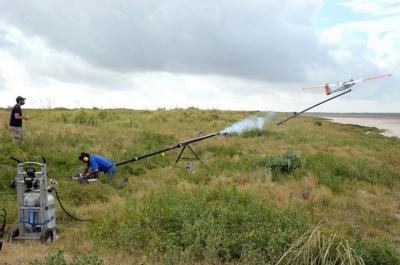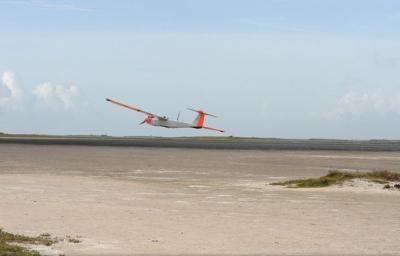First Missions Flown This Week Over South Texas Ranchland
Texas A&M University-Corpus Christi’s Lone Star Unmanned Aircraft Systems (UAS) Center is conducting a series of flight missions this week, the first since becoming fully operational as a federally-designated test site. Researchers conducted missions Wednesday and scheduled additional flights Thursday with the University’s RS-16 unmanned aerial vehicle (UAV).

The FAA designated the center as one of only six test sites in December, and approved it as operational on Friday, June 20.
“The Texas test site will provide critical data to the FAA, which they need to develop rules, processes and procedures required to safely operate UAS in the national airspace,” said Dr. Luis Cifuentes, Vice President of Research, Commercialization and Outreach at Texas A&M-Corpus Christi. “Texas is open for research, development, testing and evaluation offering diverse geography and climates.”
In the six months since the test site designation, the Lone Star Center has been preparing to receive private companies and other organizations that want to test and research aircraft, software or other possible uses for unmanned aircraft, commonly referred to as drones.
The missions will address several of the FAA research goals designed to safely integrate unpiloted aircraft into the national airspace by 2015, including:
- system safety and data gathering as it relates to marine environments;
- best practices for use of a chase plane that can more efficiently match speed and follow the UAV; and
- continue refining process of ensuring air traffic control communications between UAV, ground control station and Mission Control Center in Corpus Christi.
During these missions, the UAV will launch from a mobile operations center, fly east out of sight of ground observers, and will be monitored by a piloted aircraft as it flies over Padre Island and the Gulf of Mexico. Regulations require that the drone remain under visual contact at all times.
“The data we collect during this mission will help the FAA determine best practices for integrating unpiloted aircraft into the national airspace,” said Dr. David Bridges, Director of the University’s UAS Program. “A study of our radio link procedures during this mission will tell us what works best in this area, given its terrain, climate and transmission situations from the UAV, to the ground control station and back to Corpus Christi with the Mission Control Center. “This is also the first time we’ll be out in the heat of the South Texas summer, so we’ll be able to determine if conditions, which can include an increase of scorpions, snakes and mosquitoes, affect the flight and crew.”
The mission will also gather video, ultraviolet and thermal image data from the onboard multi-spectral camera for University researchers monitoring coastal habitats and shoreline changes.
Collecting this kind of aerial imagery is vital to research, business and safety. Areas of use for UAS are likely to include:
- search-and rescue missions, surveying disaster areas or accident scenes;
- mapping coastlines to observe changes over time;
- and inventory of wildlife, habitats, agriculture and pipelines through remote areas.
- The RS-16 is the University’s largest UAV, with a wingspan of nearly 13 feet and a maximum weight of 85 pounds. It launches with a pneumatic catapult and lands on its belly in the soft mudflats common in this coastal Texas region.

Since 2011, the University has conducted regular flights of its RS-16; the last missions were in March under provisions of a previous FAA agreement.
The University has established a UAS Mission Control Center at the Coastal Bend Business Innovation Center that will manage the proposed 11 Texas test ranges. In addition to the range near Sarita, the center has pending approvals before the FAA for ranges in the Beeville and Port Mansfield areas.
The University will file a report with the FAA within 45 days of the mission, part of the requirements of test site operators.
While test site research is not used for academic purposes, the University is developing its UAS programming and has seen an increase in interest from prospective and current students with talents in engineering, technology and software, business applications, or surveying science.
In late May, the FAA approved another University UAV, a super light fixed-wing aircraft weighing less than 2 pounds, for flight over the campus to map and monitor facilities, derive 3-D models and assess coastal hazards facing the island campus.
“One of the big efforts for unmanned aircraft technology here at A&M-Corpus Christi is coastal and marine applications,” said Dr. Michael Starek, Assistant Professor of Engineering. “Using UAVs to collect data in coastal and marine environments will greatly improve our ability to monitor and understand changes in these environments by enabling us to collect data more often and at lower costs. It will also allow for more efficient response to critical events, such as hurricane impacts.”
While the test site designation does not come with federal funding, studies show an anticipated economic impact, once airspace is opened to UAS, would be about $6.5 billion and 8,256 jobs statewide from 2015 to 2025.
(Images provided by Texas A&M University)
 Airborne 04.16.24: RV Update, Affordable Flying Expo, Diamond Lil
Airborne 04.16.24: RV Update, Affordable Flying Expo, Diamond Lil ANN's Daily Aero-Term (04.20.24): Light Gun
ANN's Daily Aero-Term (04.20.24): Light Gun Aero-News: Quote of the Day (04.20.24)
Aero-News: Quote of the Day (04.20.24) Aero-News: Quote of the Day (04.21.24)
Aero-News: Quote of the Day (04.21.24) ANN's Daily Aero-Term (04.21.24): Aircraft Conflict
ANN's Daily Aero-Term (04.21.24): Aircraft Conflict




